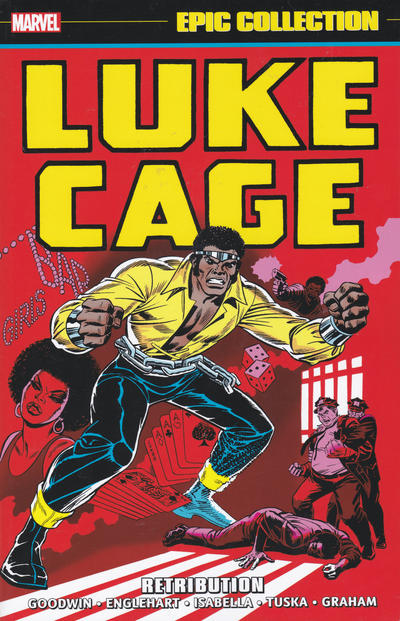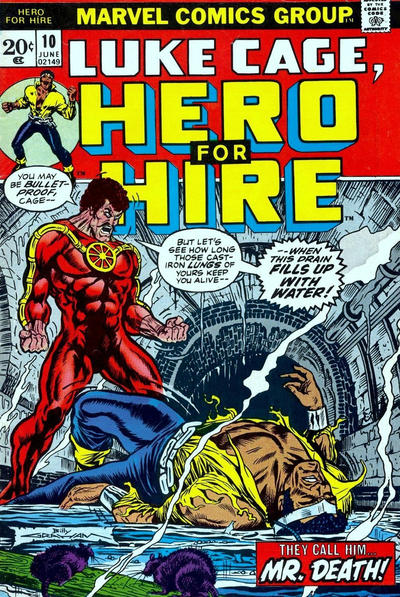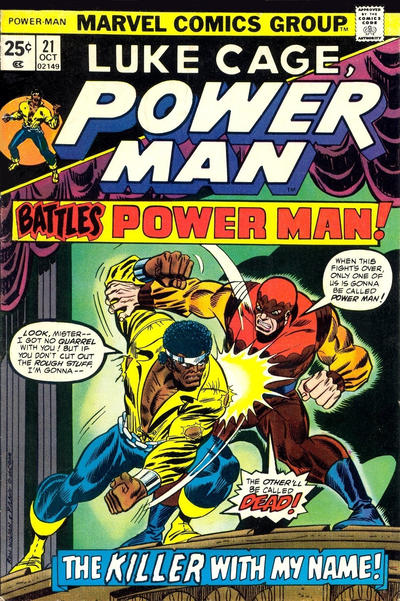I've always cottoned to comic book stories that deal with the logistics of vigilantism. The classic Fantastic Four story when they go broke and end up working for the Sub-Mariner at his movie studio is a delightful story which points back to the real world as most good stories do. The Avengers from time to time have had stories which mentioned the stipends the heroes get while they serve among the ranks. But no Marvel story hit on the economics of heroism more directly than Luke Cage, Hero for Hire. The Epic collection of Luke's earliest adventures emphasizes his name but when the comic first started to show up on comic book spinner racks it was "Hero for Hire" that branded the comic most forcefully.
We meet Lucas when he is an inmate at Seagate Prison and he's there for a murder he did not commit, the murder of his beloved. His former compadre "Diamondback" set him up and now he stews about his unfair situation while using his fists to defend himself. He's offered the chance to participate in a lab experiment conducted by a Dr. Burstein and it turns out to give Lucas a steel-hard skin and enormous strength and endurance. He literally busts out of prison takes on the ironic name of "Luke Cage" and decides to help those who need help but for a price. Luke cuts a striking figure on the debut cover by John Romita and that look with the blue (black?) descending into his boots is the ideal. He looks rather like Fred Williamson.
In the second issue he gets his revenge on Diamondback and makes it known to the criminals of Harlem that a new hero is on the block. This is "blaxploitation" at its finest, a yarn about an angry black man who has complicated issues with the civil authority and who seeks to do good but must needs look for himself in the bargain. These early issues really evoke that Shaft vibe.
By the third issue he's fighting a mercenary named "Gideon Mace" and his mob and is not getting much money for his troubles. It turns out not surprisingly that Luke is a much better hero than businessman. Doc Burstein returns to the story and agrees to hold Luke's secret for a time and we also meet a bonafide love interest in Dr. Claire Temple. Mace appears to drown as the story closes.
The art in the first three issues had been magnificently done by veteran George Tuska with inks by up and coming African-American artist Billy Graham. But in the fourth issue Graham does all the work in a story which has a Phantom haunting the very neighborhood in which Luke keeps his office. It's above a movie theater run by a friendly young kid named "D.W." after the infamous movie director D.W. Griffith. I'm not sure if the writer Archie Goodwin intends to invoke memories of Birth of a Nation but it's hard not to think so.
Tuska is back in the fifth issue, but Goodwin is gone, replaced by Steve Englehart. This issue features one of Luke's most memorable villains, the robust "Black Mariah" who runs an ambulance scam in NYC.
Graham takes the lead again with inks by Al Williamson for an indifferent product. The story too seems off the beaten path as Luke goes to the suburbs to battle armored ghosts in a story about a dangerous inheritance.
One of my favorite Cage stories from this era is the delightful and dangerous Christmas yarn that Englehart and Tuska spin which weirdly evokes A Christmas Carol and Dr. Strangelove at the same time.
Then we are treated to a nifty two-parter when Luke comes up against Marvel's top baddie, Doc Doom. First Cage is hired by Doom to chase down some errant robots hiding in Harlem but when the Monarch of Latveria tries to stiff Cage on his fee of two hundred bucks, the Hero for Hire hops over to the tiny kingdom to get his pay. The FF make an appearance and give Luke a rocket to get over to Latveria, This is an early effort to bond Cage more tightly to the larger Marvel continuity.
One of my favorite Hero for Hire villains is "Mister Surete/Mister Muerte" or "Mister Luck/Mister Death". He's a gambling crime boss who depends on his good fortune to defend his casino operations and has a trick where he spins a wheel which charges up one of his hands with deadly electricity. One handshake is all it takes to burn you to a crisp. He's an arrogant villain who cannot understand why Cage keeps coming at him over the course of their two-issue battle.
One of the more successful villains from this run is "Chemistro" who wields a handgun that can change one substance into another such as steel becoming glass. This Alchemy Gun is a deadly weapon and it's all Luke can do to survive long enough for the villain, a disgruntled ex-employee of a car manufacturer to be hoist on his own petard. Cage's appearance in Amazing Spider-Man is referenced in this issue.
Luke Cage always seemed to have the most curious and interesting rogues to battle. Not least among them was Lion-Fang, a disgruntled scientist who used his knowledge to share intelligence with large cats and got from them some degree of ferocious energy. Needless to say, it didn't turn out for him in the end.
The last three issues of Luke Cage, Hero for Hire were comprised of a three-part tale that reintroduced several characters from the debut issue such Shades and Commanche, two inmates of Seagate who escape and try to set up a protection racket. And Luke's arch nemesis Rackahm, the guard to actually was instrumental in making Cage so powerful turns up again, even more repulsive than before. But first Cage has to fight the giant lawyer named Big Ben who is harassing Mrs. Jenks, a woman Cage had done work for in previous issues.
She ends up getting kidnapped and a reporter trying to blackmail Cage gets murdered by Rackham but Cage's girlfriend Claire Temple gets arrested for the crime. In an effort to clear her he gets into all sorts of trouble. Billy Graham turns in some of his best work while Tony Isabella steps in to script the story begun by Englehart.
Frank McLaughlin handles the inks over Graham's pencils on the third part which introduces a new villain called "Stiletto". Both Shades and Commanche help Cage put down this baddie and by the end Cage's secret is safe once more, but a few people do have to die.
Luke Cage (and the boffins at Marvel) decided that he needed a new monicker for his hero trade, so in this issue he ponders several options striking at last on "Power Man" (as in "Black" Power Man I reckon). It's fine and it's worked for him ever since, but I always preferred the more mercenary "Hero for Hire" label. In this issue Luke is duped into trying to steal some Stark armor and battles old Shellhead himself. George Tuska is back on pencils and Billy Graham bids farewell to Cage with a dandy inking job. The newly titled book slips to a bi-monthly schedule with this installment.
Vince Colletta takes over on inks over Tuska's pencils for the next several issues. In eighteen Power Man battles yet another disgruntled worker, this one on the high steel as the "Steeplejack" seeks revenge for two of his brothers who fell. This issue is the first written by Len Wein.
The team of Wein, Tuska and Colletta then gives us a two-part tale which has Luke Cage finally seek out the pusher who sold the drugs he was accused of possessing so very long ago. It turns out it is a macabre mobster named "Cottonmouth".
Luke pretends to work for Cottonmouth in order to gather the evidence he needs to clear his record, but his mission is a fail, though he does bring down Cottonmouth's drug operation.
Len Wein gets help from returning scribe Tony Isabella for the next misadventure. This issue also sees the arrival of Ron Wilson on pencils. Wilson is a much less accomplished talent than the veteran Tuska but Colletta's inks hold things together. This is a memorable issue in that the original villainous Power Man comes seeking some payback from Luke Cage for ripping off his title. The fight for it and of course Luke wins.
Stiletto returns this time with his beefy brother Discus in tow. The two of them battle Power Man in an issue that's pretty much all action. We do find out what motivates Stiletto to some extent, and it means the return of a a character from Luke's past, someone from the very first issue -- the progressive warden from Seagate who allowed Burstein's experiments on Lucas to begin with. Reference is made in this issue to Power Man's appearances in The Defenders.
Isabella and Wilson are joined by inker Dave Hunt for the last issue in this collection which sees Luke and his buddy D.W. head to Los Angeles following Claire Temple who had suddenly left NYC and left only cryptic note as to why. Luke and D.W. are riding a bus which goes by "Security City", a well-armed community for all the right people. It's run by old Cage villain Gideon Mace, who didn't die after all. (Do they ever?)
As I read these Hero for Hire stories again, I was struck by the anger Luke feels nearly all the time. He has that office in a low-rent part of NYC and it's a good thing since he destroys the fixtures at least once an issue. Either he does in a fight or he just loses his temper and smashes something. Luke Cage is a man who has been treated unjustly and is now working outside the law but also in tandem with it to bring villains to some degree of justice, albeit natural justice at times. He's a hero always seeking to treated on an equal basis with the other heroes in Marvel Universe who he percieves as having fewer obstacle in their way in that regard.
"Blaxploitation" is about giving black audiences heroes they can root for and since many if not most Black citizens at the time were just getting adapted to a society which was just then legally beginning to treat them as regular citizens. It remains an incomplete process alas. Luke Cage, Hero for Hire speaks to that anger and frustration and presents that audience with a superhero who shows his face with pride and demands that he be treated with respect.
Rip Off




























Not 100% sure, but I think I first encountered Luke Cage in a Marvel treasury Edition 'Grab-Bag', in which the Christmas story from issue #7 was reprinted (I assume). Of course, Spider-Man was nearly Marvel's first 'hero for hire' when he approached the FF looking for a job. Not too bright of Peter Parker to assume that being a superhero was a paying gig.
ReplyDeleteI had forgotten Spidey's attempt to get some filthy lucre for his efforts, a great catch on your part sir. Thanks.
DeleteLuke Cage just reeks of the 1970s to me and those early covers are amazing so full of energy and action, I love them. At the time I only picked up issues 12 and 21 ( the cover to issue 17 is a cracker). My introduction to Luke Cage was in the UK weekly's ( I think the Mighty World of Marvel) but they were poorly presented with that awful greytone added which put me off reading it. I loved Frank Robbins two issue run on the strip, then again I am a Robbins fan.
ReplyDeleteIt's always nice to hear good things about Frank Robbins. I'm a fan but so many are not. I'd forgotten about his work on Power Man, but I had not forgotten the work of an artist if a similar style on the character -- Lee Elias. The Hero for Hire book had some outstanding talent associated with it.
DeleteThe Christmas story in #7 mentioned by Kid appeared in the 1975 Giant Superhero Holiday Grab Bag (which I owned).
ReplyDeleteThe cover of #17 claims that Luke Cage is "The First And Greatest Black Superhero"...er, Black Panther came first but a couple of other covers do say AMERICA's first black superhero.
The Black Panther did indeed precede Cage, but he's from Wakanda. I know that a nit I have just picked and forgive me. (You know how America is about its black heroes --gotta' check those birth certificates.) But even given that, the Falcon arrived befor Cage, so it's not true anyway.
DeleteGeorge and Vince excelled on this series, beyond what other Marvel artists were doing.
ReplyDeleteGeorge Tuska was one of those workhorse talents who didn't get nearly enough credit while he was working.
DeleteRe: Cage and Spidey-- the two of them square off in a SPIDEY issue clearly designed to hype HERO FOR HIRE, and Spidey gets torqued because Jameson hired Cage to play hero-hunter, though eventually Cage demonstrates that he's just as capable of telling The Man to take his job and shove it. It's also the only fight-scene in the Conway-Andru period of SPIDER-MAN that I thought was at all memorable.
ReplyDeleteI think I must have more regard for Ross Andru's run on Spidey, a period when the hero matured immensely. But that is a dandy issue.
Delete